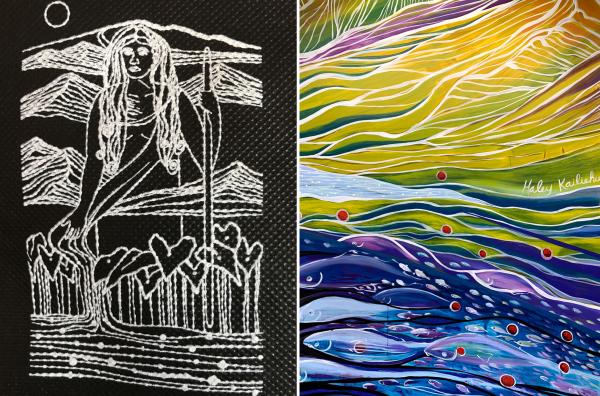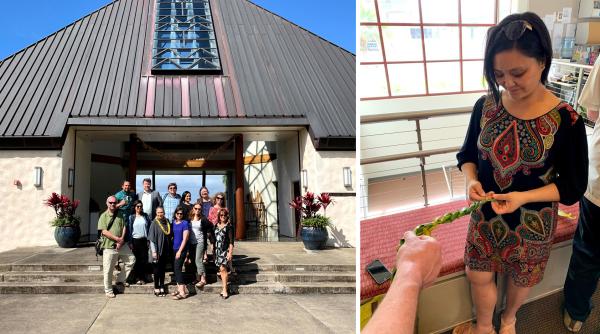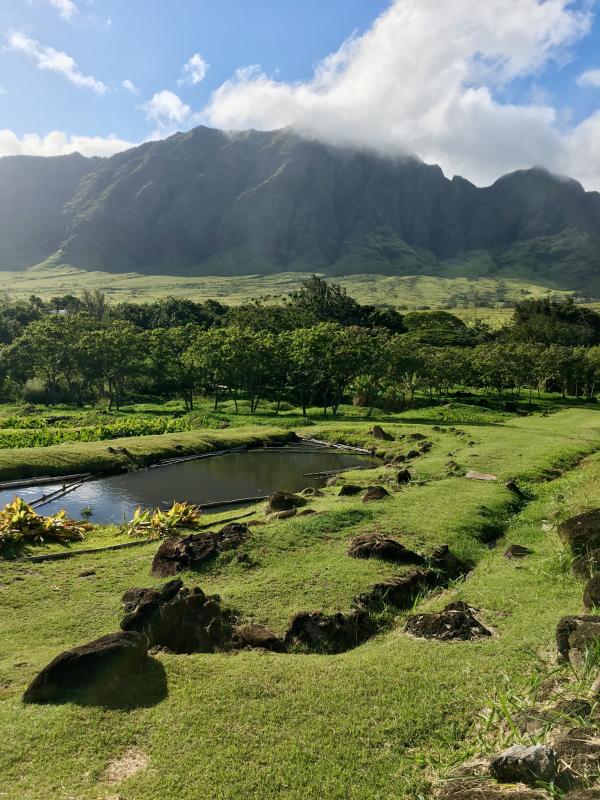Telling the Story of Ourselves: Who are you -- now?
Aimee was recently one of ten Burlington area educators who traveled to Hawai’i to explore the power of place-based and culture-based education and to strengthen a partnership that began last summer in Burlington. The partners: Shelburne Farms, UVM College of Education and Social Services, UVM Rubenstein School of Environment and Natural Resources, and Kamehameha Schools are working together to advance place-based education.
Introductions
Hello. My name is Aimee. I work on the education team at Shelburne Farms.
This is how I introduced myself at the first site we visited on our Learning Journey to Hawai’i. At each of more than a dozen educational sites on the islands of Oahu and Hawai’i, we were warmly greeted by our respective hosts and invited to stand in a circle for a welcome and a gracious round of introductions.
As we moved through our first day of five site visits, I found that I got better at introducing myself. At some point I picked up on the Hawaiian host’s custom of calmly and clearly introducing herself with her full eight-syllable name. By the next morning, my introduction was:
Good morning. My name is Aimee Arandia Østensen. I’m a professional learning facilitator in education for sustainability at Shelburne Farms. I had dropped the apologetic tone I often use because my names can be hard for others to hear and pronounce.
The invitation to share our stories as a means of introduction varied slightly from place to place, person to person.
In the world of educating for sustainability, we endeavor to help people develop a strong sense of place. We emphasize questions like: How are we shaped by the land? How do we shape the land? What are the stories here? How does where we live impact how we live? In our Hawaiian circles of introduction, our hosts were inviting us to share our connections to place and modeling for us how this relationship is uniquely personal and dynamic. Our sense of place starts with a sense of self.
Ahupua’a
All the schools, community farms, and land- and sea-based education sites that we visited shared the same mission: to transform Native Hawaiian communities through culture-based education. While each person’s story and their approach to their work was unique, I kept hearing one word woven into the introductions of themselves and their organizations: ahupua’a.
At first, I thought that perhaps ahupua’a referred to the watershed. But it was soon described as being “a tract of land from the mountain to the sea.” The term immediately made sense within the unique geography of Oahu. No matter where you stand there, you can readily see the mountain, the valley, the spines of the mountain, and the sea of the particular ahupua’a you are within.
A community center leader spoke of the features and health of the land and people in their ahupua’a and how both have changed together over time. Teachers at a school described the spines of the mountain range as landmarks circumscribing their school’s home neighborhood. A traditional taro farmer told of the process of revitalizing the land, animals and people of his ahupua’a as he struggled to and succeeded in bringing the mountain’s water back into the valley.
Their stories gave a more complete definition of an ahupua’a: “a tract of land from the mountain to the sea that supplies everything your community needs to survive.” It is more than a geographic or ecological concept. It also evokes social connections, political dynamics, technology, local culture, and interconnectedness with other living things through the past, the present and the future. It represents a profound understanding of place and community, and one’s self within them.
One morning we joined a school group for their morning community meeting. For introductions, we were invited to , “Share something about the place where you come from.” We offered stories of a Vermont landscape covered in a blanket of white snow for months, school being closed because of too much snow, and “surfing” down mountains of snow. Being from New York State myself, I described the New York City equivalent of the ahupua’a. “We have mountains and a big river that flows down to the sea. The river and the sea are very close to the city, but the mountains are hours and hours away.”
What’s your Backstory?
At another school, a group of 4th grade students were asked, “If you could talk to students from Vermont, what would you ask them?” Two responses surprised me and have lingered in my mind: “What’s your backstory?” and “What’s your past, your present and your future?” Their questions captured an idea that had been forming in the back of my mind all week:
Identity is a living, evolving story. What we reveal of ourselves is dynamic and responsive. It reflects a backstory and the present context and company of the conversation. As our group of educators from Vermont moved along our learning journey, I found that our stories of ourselves changed slightly along the way. Details that seemed out of place in one setting would surface beautifully in another. We were moving beyond name, employer and job title to sharing tidbits of our story. The tidbits offered seemed to reflect where we were--on a boat, on a farm, in a school, in a museum at a community center and who we were with--navigators, educators, farmers, researchers, and community activists.
On our final visit, we were hosted by Cheryl Ka‘uhane Lupenui of the Kohala Center, an independent, community-based center for research, conservation, and education on the Big Island of Hawai’i. We gathered in a circle and Cheryl welcomed us with a song and story. She invited to share three things: where you were born, where you live, and where you are from.
My name is Adele Aimee Altobano Arandia Østensen. I was born near a sacred lake in Upstate New York that is now a Superfund site. I live in New Haven, Vermont and the Catskill Mountains of New York. I am from my mother’s island in Romblon and my father’s island of Luzon--the big island of the Philippines.
Where were you born? Where do you live? Where are you from? What’s your backstory?

 with Vermont group.](/sites/default/files/styles/full_width_narrow/public/eric_enos_of_kaala_farm.jpg?itok=sosGKs7o)


